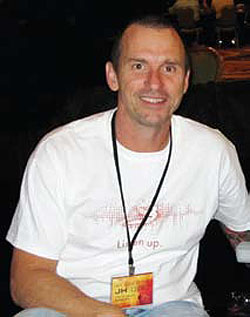
“We were moving Dave’s office, I was young, and wanted a job, so I busted my butt.”
“And he said, ‘hey, what do you do?’ I said I’m a sound guy, and he said, ‘I don’t need a sound guy; can you tune a bass guitar?’ I said absolutely, so there I was, working for David Lee Roth.”
On Roth’s 1987 “Skyscraper” tour, Harvey was unofficially adopted by the TASCO crew, and that association led to a gig as monitor engineer for one of the openers on The Cult’s “Sonic Temple” tour.
Soon enough he was mixing monitors full time; first for Roth and a variety of TASCO’s other rock clients, including KISS.
Later, after A1 Audio bought TASCO, he continued to work with A1 clients such as k.d. lang, Engelbert Humperdinck, Louis Miguel and others.
“Front of house was the glamour gig, but once they put me on monitors I never left. If you were good, you could work as much as you wanted to.” Clearly, he wanted to work a lot, and between 1985 and 2003, averaged 300 days a year behind the desk.
Thing To Maintain
For a monitor engineer, Harvey says, a good bedside manner is key to being able to deal one on one with artists and meet their needs.
Sometimes, however – either because of technological limitations or a lack of communication – it’s a difficult thing to maintain. Such was the case with Gene Simmons during an early 1990s KISS tour.
“In Gene’s defense, the gear couldn’t do what he was expecting, and I couldn’t make it, so I caught a lot of grief.” To cope, he found himself a “sub” – a life-size cardboard cutout of drag car racer Big Daddy Don Garlits he’d liberated from a service station, disguised with a baseball hat, KISS tour shirt, and a “sharpied” beard like his own.
“When Gene would come over and yell at me, I’d set the cutout up beside the desk, walk off and cool down. The rest of the band knew but because of a black scrim in front of the desk and the way the light was set, Gene didn’t.”
Eventually, their working relationship smoothed out and Big Daddy could be retired. “Gene came over to me one day and said, ‘Jerry, why don’t you take the information that I’m giving you and do something with it? And I said, ‘Gene, you’re not giving me information, you’re giving me grief, and not once will you tell me what the problem is.
“That night he came stomping across the stage and I thought, ‘here we go’, but he leaned down and said, ‘Jerry, my vocal is muffled, can you brighten it up? And I was like, ‘I can do that.’ He walked back, smiled at me, and from then on we had communication.”
A Big Change
In 1995, on his first tour with Van Halen, Harvey found himself challenged again, this time by a purely technological problem that would alter his career dramatically.
“They wanted to put Alex on in-ears, to prevent any potential hearing loss, but at that time there were really two companies that did in ears and the earpieces were an afterthought. Neither cut it, and Alex looked at me and said, ‘you want to keep mixing this thing? Make the earpieces sound presentable, or find a better earpiece.’ He wasn’t rude, but he was curt. They were the highest profile client I’d worked for and I needed that gig, so I started researching.”
Six months later, he had a working prototype. “I’d sit at my console with a Klark Teknik DN6000 analyzer, an Earthworks mic and modeling clay, testing components.
We found the high frequency driver, but I couldn’t find anything for lows that wouldn’t crap out when you put a kick drum through it.” Eventually, Rick Zanardo, Harvey’s contact at Knowles Acoustics, found a fix in the company’s “balanced armature graveyard.”
